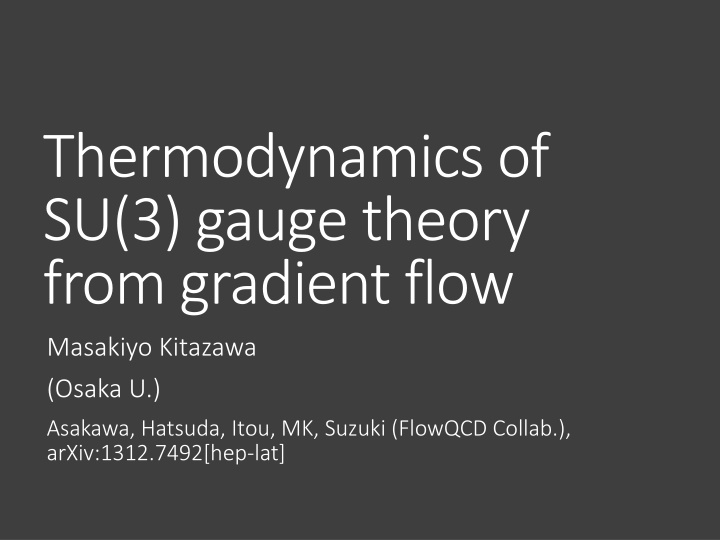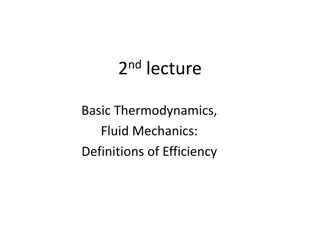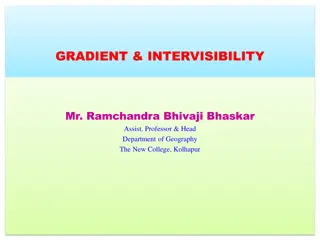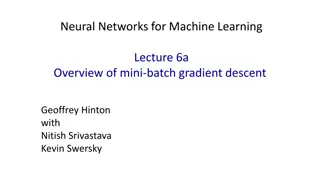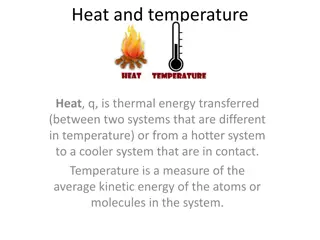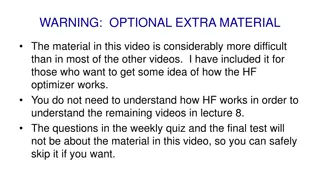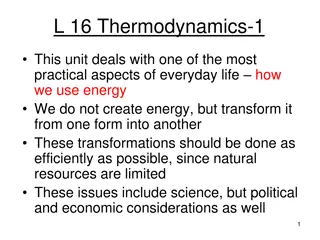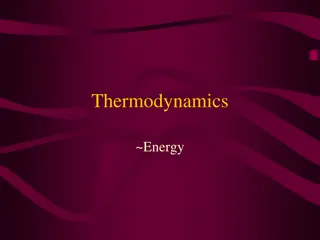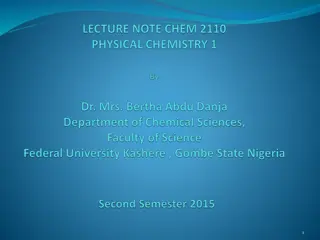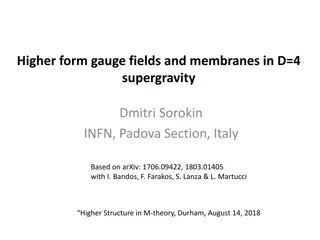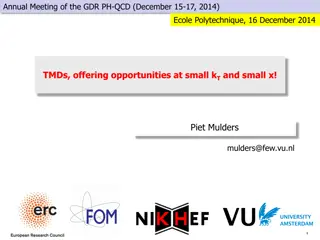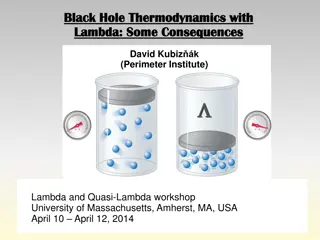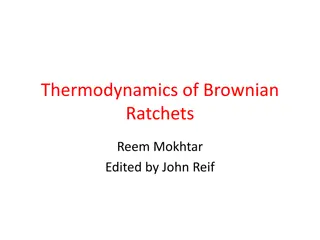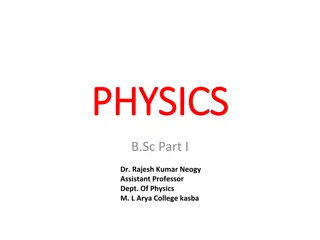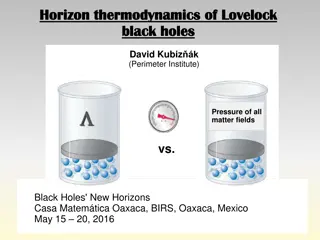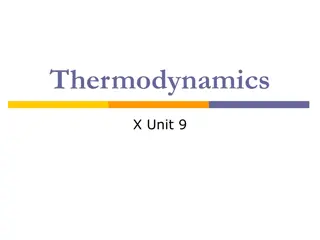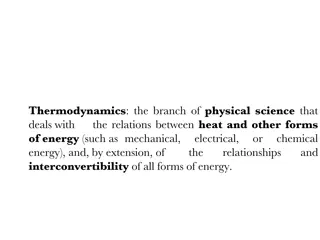Exploration of Thermodynamics in SU(3) Gauge Theory Using Gradient Flow
Investigate the thermodynamics of SU(3) gauge theory through gradient flow, discussing energy-momentum stress pressure, Noether current, and the restoration of translational symmetry. The study delves into lattice regularization, equivalence in continuum theory, and measurements of bulk thermodynamics, including energy density, pressure, correlation functions, and viscosity. The research also explores non-Gaussian fluctuations, specific heat, and vacuum structure, providing insights into the QCD equation of state and the transition from hadronic to Quark-Gluon Plasma phases.
Download Presentation

Please find below an Image/Link to download the presentation.
The content on the website is provided AS IS for your information and personal use only. It may not be sold, licensed, or shared on other websites without obtaining consent from the author.If you encounter any issues during the download, it is possible that the publisher has removed the file from their server.
You are allowed to download the files provided on this website for personal or commercial use, subject to the condition that they are used lawfully. All files are the property of their respective owners.
The content on the website is provided AS IS for your information and personal use only. It may not be sold, licensed, or shared on other websites without obtaining consent from the author.
E N D
Presentation Transcript
Thermodynamics of SU(3) gauge theory from gradient flow Masakiyo Kitazawa (Osaka U.) Asakawa, Hatsuda, Itou, MK, Suzuki (FlowQCD Collab.), arXiv:1312.7492[hep-lat]
energy momentum stress pressure Noether current / generator of space-time translation
energy momentum stress pressure Noether current / generator of space-time translation Einstein Equation Hydrodynamic Eq.
The definition of on the lattice is nontrivial because of the lack of translational symmetry cf) Caracciolo+ (1989)
Rough Idea coarse graining no translational invariance translational symmetry is recovered!
lattice regularized lattice regularized gauge theory gauge theory YM gradient flow continuum theory ( with dimensional regularization ) continuum theory ( with dimensional regularization ) YM gradient flow Luescher, Weiss (2012) Suzuki (2013)
lattice regularized lattice regularized gauge theory gauge theory YM gradient flow equivalent! UV finite analytic relation (in perturbation) continuum theory ( with dimensional regularization ) continuum theory ( with dimensional regularization ) YM gradient flow Luescher, Weiss (2012) Suzuki (2013)
What we can measure with bulk thermodynamics (energy density, pressure) correlation functions viscosity, thermal excitation vacuum structure? fluctuations, specific heat non-Gaussian fluctuations, etc. Asakawa, Ejiri, MK (2009) pink chars: T>0 physics
QCD EoS (Energy Density, Pressure) BNL-Bielefeld 2011 hadronic QGP Rapid increase of /T4around T=150-200 MeV Crossover transition Rapid but smooth change of medium from hadronic to QGP-like
QCD Thermodynamics Thermodynamic relations How do we take T and V derivatives?
Lattice Spacing Derivative Changing lattice spacing 1/T and V change -
Differential Method anisotropic lattice with 2 independent beta functions perturbative result Karsch(1982) negative pressure with Karsch coeffs. vacuum subtraction
Integral Method Boyd+ 1996 measurements of e-3p for many T vacuum subtraction for each T information on beta function
Gradient Flow Luescher, 2010 t: flow time dim:[length2] steepest descent direction of the action
Gradient Flow Luescher, 2010 t: flow time dim:[length2] steepest descent direction of the action modify gauge field toward the stationary point of the action smoothing similarly to diffusion equation diffusion length All composite operators at t>0 are UV finite Luescher,Weisz,2011
Operator Relation Luescher, Weisz, 2011 an operator at t>0 remormalized operators of original theory
Constructing EMT Suzuki, 2013 gauge-invariant dimension 4 operators
Constructing EMT 2 Suzuki, 2013 Suzuki coefficients
Constructing EMT 2 Suzuki, 2013 Suzuki coefficients Remormalized EMT
Numerical Simulation on the Lattice
Gauge field has to be sufficiently smeared! lattice regularized lattice regularized gauge theory gauge theory YM gradient flow equivalent UV finite analytic relation (in perturbation, operator expansion) Perturbative relation continuum theory ( with dimensional regularization ) continuum theory ( with dimensional regularization ) YM gradient flow has to be applicable!
solve gradient flow for each confs. measure U and E lattice regularized lattice regularized gauge theory gauge theory YM gradient flow equivalent UV finite generate gauge configurations obtain T with Suzuki formula analytic relation (in perturbation, operator expansion) continuum theory ( with dimensional regularization ) continuum theory ( with dimensional regularization ) YM gradient flow take a 0, t 0 limit
Numerical Simulation 1 FlowQCD, 1312.7492 SU(3) YM theory Wilson gauge action lattice size: 323xNt Nt=6, 8, 10 configurations: 100-300 Scale setting: alpha Collab., NPB538,669(1999)
YM Thermodynamics Emergent plateau! systematic error There exists a wide range of t at which the Suzuki formula is safely used with Nt=10.
YM Thermodynamics Emergent plateau! systematic error There exists a wide range of t at which the Suzuki formula is safely used with Nt=10.
Continuum Limit Boyd+1996 Statistical error of e-3p is significantly smaller than Boyd+1996 which used ~10000 confs. No integral! Direct measurement of e and p at a given T no vacuum subtraction for e+p
Numerical Simulation 2 SU(3) YM theory Wilson gauge action lattice size: 323xNt Nt= 6, 8, 10, 32 configurations: 100-300 = 5.89 6.56 twice finer lattice spacing! lattice size: 643xNt Nt= 8, 10, ,16, 18, 64 configurations: ~2000 = 6.4 7.4 On BlueGene/Q @ KEK Efficiency of our code: Gauge update HB+OR) ~25% Gradient flow (RK4) ~40%
t Dependence of e+p NEW!! NEW!! preliminary Plateau region extends toward small t! FlowQCD,1312.7492
Summary EMT formula from gradient flow Our strategy can successfully define the EMT on the lattice in practical simulations This operator provides us with novel approaches to measure observables on the lattice! They are direct, intuitive and less noisy
Many Future Works precision measurement of YM thermodynamics EMT correlation functions measurement of viscosity specific heat, non-Gaussian fluctuations, etc. scale setting taking double limit a 0, t 0 full QCD Makino,Suzuki,1403.4772 to from Hydrodynamic flow Gradient flow
EMT Correlator Kubo Formula: T12correlator shear viscosity Hydrodynamics describes long range behavior of T Energy fluctuation specific heat
EMT Correlator: Noisy With na ve EMT operators Nakamura, Sakai, PRL,2005 Nt=8 improved action ~106configurations Nt=16 standard action 5x104configurations no signal
smearing length 643x16 =7.2 (T~2.2Tc) 1200 confs converge at improvement of the statistics at large t
Correlation Function 643x16 =7.2 (T~2.2Tc) 1200 confs t/a2=1.9 C44( ) :constant conservation law! C12( ) smeared C41( ) negative i2=-1
Energy Fluctuation and Specific Heat Specific Heat 643x16 =7.2 (T~2.2Tc) 1200 confs
Energy Fluctuation and Specific Heat Specific Heat 643x16 =7.2 (T~2.2Tc) 1200 confs Gavai, et al., 2005 differential method for T=2Tc Novel approach to measure cV
